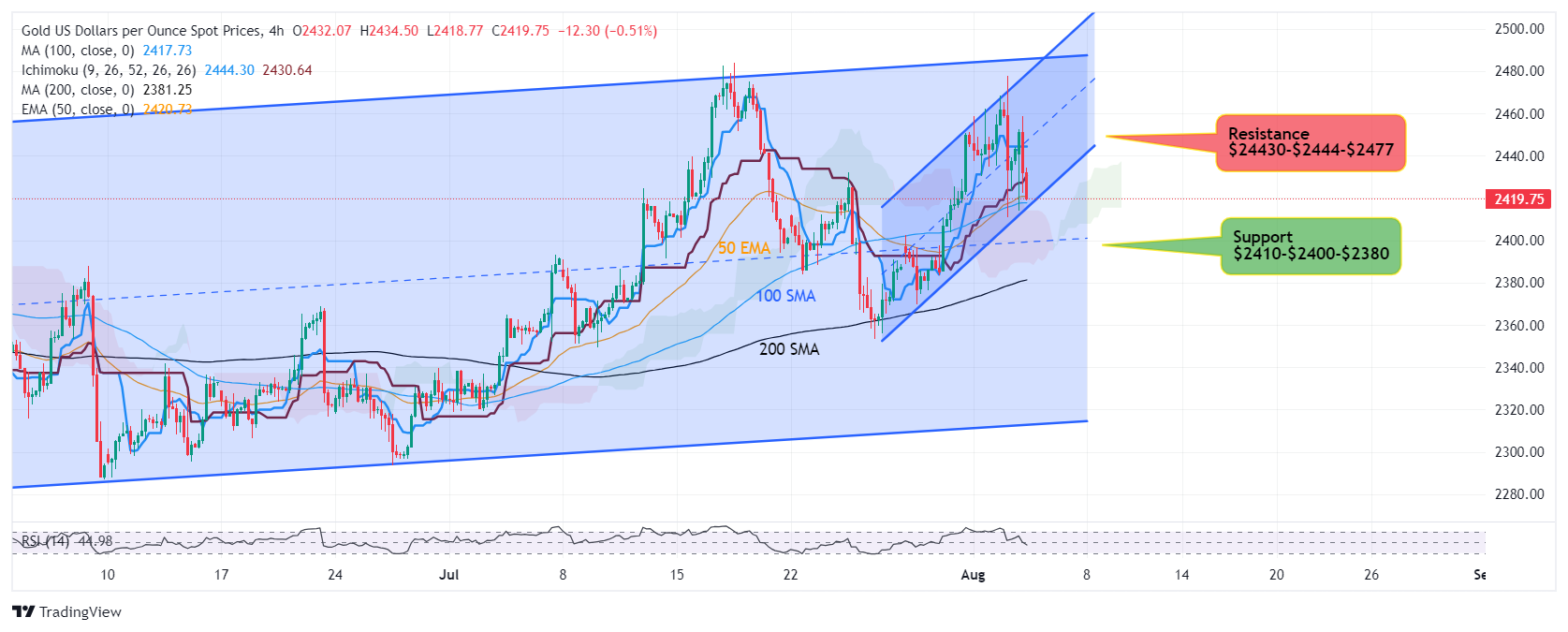Key Insights
- Gold price remains defensive despite Middle East tensions and dovish Fed expectations due to ‘sell everything’ market sentiment
- Weak US jobs data fuels recession fears, leading to expectations of aggressive Fed rate cuts (115 bps this year)
- Technically, gold is at a critical juncture with $2,400 as key support and $2,460 as significant resistance
Gold Fundamental Analysis
The gold market is displaying a cautious tone as we kick off the week, with prices remaining on the defensive for the third consecutive day. Traders are now turning their attention to upcoming US economic data, particularly the ISM Services PMI scheduled for release later today, in search of fresh trading catalysts.
Despite the escalating tensions in the Middle East and growing bets on a dovish Federal Reserve stance, gold is struggling to find its footing. This paradoxical behavior can be attributed to a ‘sell everything’ mentality currently gripping the markets, primarily driven by mounting concerns about a potential US recession. These fears were further fueled by Friday’s weak jobs report, which showed a lower-than-expected increase in nonfarm payrolls and a jump in the unemployment rate to 4.3%.
The disappointing economic data has led to a significant shift in market expectations regarding Fed policy. Traders are now pricing in a staggering 115 basis points of rate cuts for this year, with a 74% probability of a 50 basis point cut in September alone. This marks a dramatic increase from just a week ago when the chances of such an aggressive move were pegged at a mere 11.5%.
Adding to the risk-off sentiment, geopolitical tensions are reaching a boiling point. US Secretary of State Tony Blinken warned during the G7 meeting that an attack by Iran and Hezbollah against Israel could be imminent, potentially occurring as early as today. This has sent shockwaves through Asian markets, with Japan’s Nikkei 225 index plummeting by 12%.
Interestingly, the US Dollar has failed to benefit from its traditional safe-haven status, largely due to the dovish Fed expectations. US Treasury yields continue their downward trajectory, further undermining the greenback’s appeal. This combination of a weaker dollar and lower yields is providing some support for gold, limiting its downside potential.
Looking ahead, traders remain cautious, avoiding significant new positions in the precious metal as they await the ISM Services PMI data and closely monitor developments in the Middle East. The PMI is expected to show a slight improvement, rising to 51.0 in July from June’s 48.8.
Gold Technical Analysis

Gold initially found support at $2,410, which sparked a move towards $2,458. However, this level proved to be a bridge too far, and prices retreated, threatening to break below the $2,410 support. The next key level to watch is the psychologically important $2,400 mark. A breach below this could potentially trigger a sell-off, pushing prices down to the $2,380-$2,375 range.
Despite these bearish signals, the downside for gold may be limited. The current global uncertainties typically drive investors towards safe-haven assets like gold. There’s a possibility of momentum accumulation that could support a retest of the $2,430 level.
However, the $2,460 level remains a significant hurdle for the bulls. Only a decisive break above this resistance could reignite the bullish rally, potentially targeting the $2,484-$2,498 zone.


